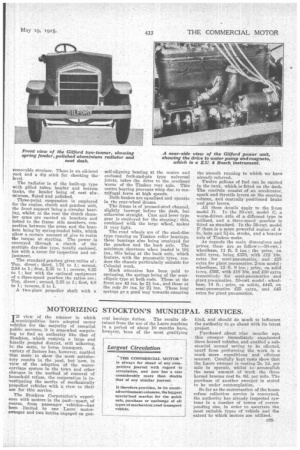MOTORIZING STOCKTON'S MUNICIPAL SERVICES.
Page 13

If you've noticed an error in this article please click here to report it so we can fix it.
IN view of the manner in which municipalities have adopted motor vehicles for the majority of essential public services, it is somewhat surprising to find an authority like that of Stockton, which controls a large and heavily peopled district, still adhering, in the main, to horse transport. A variety of factors has, however, enabled that mode to show the most satisfactory results in the past, but now, in view of the adoption of the watercarriage system •in the town and other changes in the method of removal of household refuse, the corporation is investigating the merits of mechanically propelled vehicles with a view to their use for this service.
The Stockton Corporation's experience with motors in the past—apart, of course, from passenger vehicles—has been limited to one Lacre motorsweeper and two lorries engaged on gen
eral haulage duties. The results ob tained from the use of the Lacre machine in a period of about 10 months have, however, been of the most gratifying kind, and should do much to influence the authority to go ahead with its latest project Purchased about nine mouths ago, this sweeper immediately supplanted three horsed vehicles, and enabled a substantial annual saving to be effected, apart from performing the work in a much more expeditious and efficient manner. Carefully kept costs show that the Lacre sweeper is costing 2s. ld. per mile to operate, whilst to accomplish the same amount of work the three horsed brooms cost 6s. 6d. per mile. The purchase of another sweeper is stated to be under contemplation.
So far as the motorization of the house refuse collection service is concerned, the authority has already inspected systems in a number of towns of corresponding size, in order to ascertain the, most suitable types of vehicle and the extent to which motors are utilized.




























